
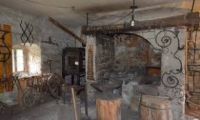
An Old Forge
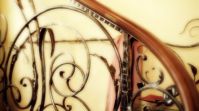
Artistic metalwork
A short video film showing the performance of forged products finely finished at the Iron-Art an artistic iron workshop.
The film shows the performance of a piece of balustrade made of smelting steel.
It shows the whole process of performance, starting from the design through bending steel rod, which is sandblasted and painted with a special paint to protect the balustrade from corrosion.
The master performs unique products modeled on old patterns, hand-forged and finely finished, decorated and created in the Art Nouveau style.
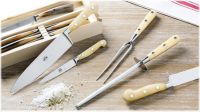
Berti knives manufacturing
The video
shows the technique used by artisans to produce a handmade knife. The artisans
work the metal when is still hot and then they give the shape; finally, they
work the wood in order to make the handle and they assemble them.
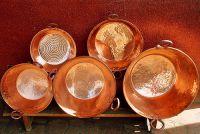
Copper and brass metalcraft
Copper is one of the first metals to be used by humans since Ancient Age. It is a metal laminable and suitable for forging and machining, so it has had a great artisanal using, both pure and in alloy with other metals, such as brass or bronze. Thanks to the excellent thermal conductivity it is used to manufacture stills, boilers, coils, etc.
Boilermaker is the ancient trade of the artisan who made cauldrons and other metal pots, to be distributed throughout the region. The process in the copperwork starts from the extraction of the ore and its washing to the fusion and ironing with tools, such as chisels and hammers, and alloy and casting at the appropriate temperature. It also includes the task of designing engravings through embossing, polishing and the techniques to add handles or picks, to weld their joints, and so on.
Copper is the most used material, as well as brass, bronze, iron, and more recently, aluminium.

Crafts and damascene processing

Cutlery from Taramundi
Cutlery is one of the most important artisan activities in Taramundi since the 18th Century. The knives have three fundamental parts, namely the blade, the handle and the ring. The main material used to make the blades is stainless steel, resistant to oxidation and wear, but more difficult to mould than carbon steel, the traditionally used material.
The artisan works the taming of the metal and carves the wood to make the handle, decorated in coloured geometrics.
The blade is made from sweet iron, brass, stainless steel and alpaca, and even silver. The handle is made with wood from the area -box and heather, as well as oak, olive, ebony, etc., or no-wooden materials such as silver, antlers of deer or cow.
The production of knives and pocket knives in Taramundi was originated as a result of the territory's own geophysical conditions, with iron deposits, abundance of water and forest wealth, which led to the installation of mallets and forges and the development of iron crafts.
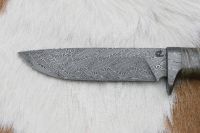
Damascus steel knife
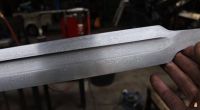
Damascus sword technique - A Damascus steel sword
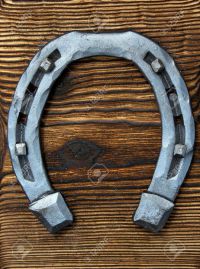
Forging handmade front horse shoe Belgian style
The video
shows the realisation of a handmade horseshoe. The artisans work the iron when
it is still hot, with hammer and other tools, giving the shape of the
horseshoe.
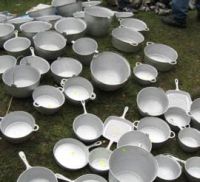
Handcrafted aluminium pot - traditional metal melting technique
In the video a craftsman show how it's made the traditional roma handcrafted aluminium pot (ceaun).
First the metal is melting then he fill a empty form (the mold) with sand and press it. He take the molten material out of the oven and he pour in to mold. He put hot charcoals all around the mold. After some time raise the pot from the pattern and polishing it, wash it and decorate it.
Roma handcrafted aluminium pots has more than two hundred years has been passed down from generation to generation
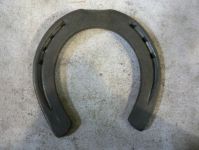
Horseshoe – metal melting traditional technique
The video shows how it is made a horseshoe and how it is place on the horse's foot.
First, the blacksmith takes a piece of iron and put it into the fire. He is waiting for the temperature to get to 1200 degrees, to be able to work it. The piece of iron is removed from the fire and the blacksmith begins to beat it. He putting it inside the fire once more and he beat the metal again and bend it until takes the form of a horseshoe. After that, he makes holes for the studs.
The blacksmith puts the metal into the fire again, to make the 2 ends, wich are curled up. He bending it a bit and the horseshoe it’s done. Now he need to shape it according to the horse’s foot. The horseshoe cannot be bigger or smaller than the horse's foot.
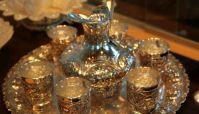
Household silverware
Foe Several household items such as vases and containers a special methos of silver smithy was used in several areas of Cyprus. The traditional decoration is a delicate craft that twists fine silver wire into beautiful hand-made decoration for most of the household items. The items were used on special occations and were sympolizing the status and wealth of the owners.
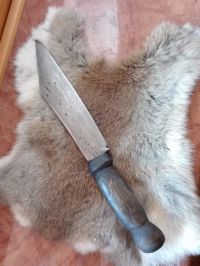
Knifemaking and iron forging

Manneken Pis
The video shows the technique used by a Belgian artisan to produce a handmade copy of the Manneken Pis.
The artisan works the iron, reproducing a perfect copy of the icon statue.
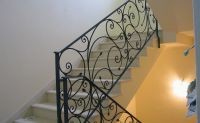
Manufacturing in wrought-iron
The video
shows the manufacturing of the iron from the initial phase. The artisans work
the iron when it is still hot, after firing inside the oven. They give the
shape to the iron using the hammer and other specific instruments. Finally, the
pieces are put together in order to create different shapes and items.

Metal Shepperd Knife

Sculptures from Granada modeled with character
Miguel Moreno is a sculptor from Granada whose work has traveled around the United States and Europe. This artist has developed an outstanding work with metal plate, and is also the author of several monuments located in different Spanish cities. In his workshop, which is opened to the public, students from European universities receive classes.
Forging and welding made with oil and bellows candle and silver welding.
The power of forging
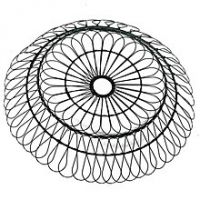
Tinker craft
Tinker craft production is registered as an intangible cultural heritage of Slovak republic. The tinkers symbolized the Slovaks in the 19th century. Originally tinkers repaired holes in metal vessels such as pots or pans, later they produced practical household things and kitchenware. The “mobile” tinkers journeyed from village to village with tinkers’ backpacks, where they had everything they needed. Later they spread from Slovakia abroad, even to distant countries, like Russia, USA, Argentina or Australia. Able wireworkers later founded professional workshops and guilds, later even manufactories. Although this craft was gradually replaced by manufacturing at the beginning of the 20th century, it has been preserved in its artistic – craft form until now.
In the video preview is the profile of the master of folk-art production Ladislav Jurovaty. The basic material of the tinker is the wire and the basic form is the string, which is produced by winding on a needle. Subsequently, various shapes are formed from the wire, for which are used several types of tools, particularly the pliers. The artistic tinker can work according to the graphic design or according to his own imagination. His work requires a lot of time and patience, diligence and humility. The wire products are naturally ornamental.
